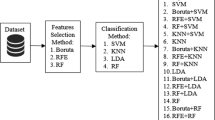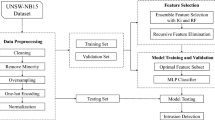Abstract
Feature selection is a preprocessing step of data mining, in which a subset of relevant features is selected for building models. Searching for an optimal feature subset from a high-dimensional feature space is an NP-complete problem; hence, traditional optimization algorithms are inefficient in solving large-scale feature selection problems. Therefore, meta-heuristic algorithms are extensively adopted to effectively address feature selection problems. In this paper, we propose an analytical approach by integrating particle swarm optimization (PSO) and the 1-NN method. The data sets collected from UCI machine learning databases were used to evaluate the effectiveness of the proposed approach. Implementation results show that the classification accuracy of the proposed approach is significantly better than those of BPNN, LR, SVM, and C4.5. Furthermore, the proposed approach was applied to an actual case on the diagnosis of obstructive sleep apnea (OSA). After implementation, we conclude that our proposed method can help identify important factors and provide a feasible model for diagnosing medical disease.



Similar content being viewed by others
References
Ai J, Kachitvichyanukul V (2009) A particle swarm optimization for the vehicle routing problem with simultaneous pickup and delivery. Comput Oper Res 36(5):1693–1702
Anonymous (1999) Sleep-related breathing disorders in adults: recommendations for syndrome definition and measurement techniques in clinical research. Sleep 22(5):667–689
Chuang LY, Chang HW, Yang CH (2008) Improved binary PSO for feature selection using gene expression data. Comput Biol Chem 32(1):29–38
Corinna C, Vapnik VN (1995) Support vector networks. Mach Learn 20(3):1–25
Duda RO, Hart PE, Stork DG (2000) Pattern classification. Wiley, NJ
Engelbrecht AP (2006) Fundamentals of computational swarm intelligence. Wiley, NJ
Fix FE, Hodges JL (1951) Discriminatory analysis-nonparametric discrimination: consistency properties. In: School of Mathematical Sciences, vol 4, pp 261–279
Gertheiss J, Titz G (2009) Feature selection and weighting by nearest neighbor ensembles. Chemometr Intell Lab 99(1):30–38
Gheyas IA, Smith LS (2010) Feature subset selection in large dimensionality domains. Pattern Recogn 43(1):5–13
Gliklich RE, Wang PC (2002) Validation of the snore outcomes survey for patients with sleep-disordered breathing. Arch Otolaryngol 128(7):819–824
Gurubhagavatula I, Maislin G, Pack AL (2001) An algorithm to stratify sleep apnea risk in a sleep disorders clinic population. Am J Resp Care 164(10):371–376
Ho TK, Basu M (2002) Complexity measures of supervised classification problems. IEEE T Pattern Anal 24(3):289–300
Hu X, Eberhart R (2002) Multiobjective optimization using dynamic neighborhood particle swarm optimization. IEEE T Evolut Comput 10:1677–1681
Jacob SV, Morielli A, Mograss MA, Ducharme FM, Schloss MD, Brouillette RT (1995) Home testing for pediatric obstructive sleep apnea syndrome secondary to adenotonsillar hypertrophy. Pediatr Pulm 20(4):241–252
Jiang Z, Yamauchi K, Yoshioka K, Aoki K, Kuroyanagi S, Iwata A, Yang J, Wang K (2006) Support vector machine-based feature selection for classification of liver fibrosis grade in chronic hepatitis C. J Med Syst 20:389–394
Kapsimalis F, Kryger MH (2002) Gnder and ostructive sleep apnea syndrome. Sleep 25(4):497–504
Kennedy J, Eberhart RC (1995) Particle swarm optimization. In: Proceedings of the IEEE international conference on neural network, vol 4, pp 1942–1948
Kennedy J, Eberhart RC (1997) A discrete binary version of the particle swarm algorithm. In: International conference systems man cybernet, vol 5, pp 4104–4108
Kennedy J, Eberhart RC, Shi Y (2001) Swarm intelligence. Morgan Kaufman, Los Altos
Kubat M, Matwin S (1997) Addressing the curse of imbalanced training set: One-sided selection. In: Proceedings 14th international conference on machine learning (ICML ‘97)
Lee JH, Cha GH (1999) A model for K-nearest neighbor query processing cost in multidimensional data space. Inform Process Lett 69(2):69–76
Lewis CA, Eaton TE, Fergusson W, Whyte KF, Garrett JE, Kolbe J (2003) Home overnight pulse oximetry in patients with COPD: more than one recording may be needed. Chest 123(4):1127–1133
Maximiliano S, Yuji T (2003) Conformational analyses and SAR Studies of antispermatogenic hexahydroindenopyridines. J Mol Struct (Theochem) 633(2–3):93–104
Netzer N, Eliasson AH, Netzer C, Krisco DA (2001) Overnight pulse oximetry for sleep-disordered breathing in adults-a review. Chest 120(2):625–633
Pang KP, Terris DJ, Podolsky R (2006) Screening for obstructive sleep apnea: an evidence-based analysis. Am J Otolaryng 27(2):112–118
Qureshi A, Ballard RD (2003) Obstructive sleep apnea. J Allergy Clin Immun 112(4):643–651
Rangayyan RM, Banik S, Desautels JEL (2010) Computer-aided detection of architectural distortion in prior mammograms of interval cancer. J Digit Imaging 23(5):611–631
Rosenthal LD, Diana DC (2008) The Epworth sleepiness scale in the identification of obstructive sleep apnea. J Nerv Ment Dis 196(5):429–431
Schäfer H, Ewig S, Hasper E, Lüderitz B (1997) Predictive diagnostic value of clinical assessment and nonlaboratory monitoring system recordings in patients with symptoms suggestive of obstructive sleep apnea syndrome. NCBI 64(3):194–199
Shepertycky MR, Banno K, Kryger MH (2005) Differences between men and women in clinical presentation of patients diagnosed with obstructive sleep apnea syndrome. Sleep 28(3):309–314
Shi Y, Eberhart RC (1998) A modified particle swarm optimizer. In: IEEE International conference on evolutionary computation anchorage Alaska, pp 69–73
Tan S (2005) Neighbor-weighted k-nearest neighbor for unbalanced text corpus. Expert Syst Appl 28(3):667–671
Wright J, Johns R, Watt I, Melville A, Sheldon T (1997) Health effects of obstructive sleep apnea and the effectiveness of continuous positive airway pressure: a systematic review of the research evidence. Brit Med J 314(851):851–860
Yeh W, Huang SW, Li PC (2003) Liver fibrosis grade classification with B-mode ultrasound. Ultrasound Med Biol 29(9):1229–1235
Young T, Palta M, Dempsey J, Skatrud J, Weber S, Badr S (1993) He occurrence of sleep-disordered breathing among middle-aged adults. New Engl J Med 328(17):1230–1235
Young T, Peppard PE, Gottlieb DJ (2002) Epidemiology of obstructive sleep apnea: a population health perspective. Am J Resp Care 165:1217–1239
Ziari I, Jalilian A (2010) New approach for allocation and sizing of multiple active power-line conditioners. IEEE T Power Deliver 25(2):1026–1035
Acknowledgments
This work is partially supported by grants from National Science Council, Taiwan, R.O.C.
Author information
Authors and Affiliations
Corresponding author
Rights and permissions
About this article
Cite this article
Chen, LF., Su, CT., Chen, KH. et al. Particle swarm optimization for feature selection with application in obstructive sleep apnea diagnosis. Neural Comput & Applic 21, 2087–2096 (2012). https://doi.org/10.1007/s00521-011-0632-4
Received:
Accepted:
Published:
Issue Date:
DOI: https://doi.org/10.1007/s00521-011-0632-4




